Vernal Equinox on Borobudur – The Expedition

The Quest for New Observatory in Eastern Indonesia
March 6, 2009
For What It’s Worth – 100 Hours of Astronomy
April 9, 2009Borobudur, the name is well known as the Buddhist monument in Indonesian. It is one of world heritage that during the decade of restoraration (between 1973-1983) involved twenty-eight countries, and in 1991 included into the World Heritage by the UNESCO. So many aspects had been studied from this monument, from the spiritual, philosophycal, architectural, and so on, but what about the astronomy? One may argue that Borobudur has nothing to do with astronomy, but as long as no strong arguments to support the lemma, it might be that the opposite can be true; regardless, the relation should be testable.
Recently, during the Vernal Equinox, i was joining the Borobudur expedition with some fellows from astronomy department, ITB. Because of Borobudur is in the central Java, so it took 9 hours land traveled from Bandung, in West Java, well, it was an exciting expedition for us. The main purpose of this expedition is on Irma Hariawang‘s thesis on archeo-astronomy, to figure out the relations between Borobudur and astronomy. And the astronomy-related activities are measuring the Sun on its path in the sky during the VE. For the detail on astronomy, i think it would be prefereable, if we have to wait for Irma’s full report in due time. Instead, i just want to share little things that i have learned during the visit.
A Visit to The Sacred Sanctuary
Borobudur was probably built between the 8th and 9th centuries, and after awhile disappeared from the existence, deep beneath the layers of ash because of volcanic eruption and then abandoned by the people around a middle age. There is a study that suggests Borobudur was abandoned following the fourteenth century decline of Buddhist and Hindu kingdoms in Java.
The Borobudur should wait until the 19th centuries when Sir Thomas Stamford Raffles, which during that period of time appointed as the British ruler in Java, and on 1814 informed by the native about an abandoned temple somewhere in the jungle, so for the first time, the world acknowledge about its existence. And since that time, there were numerous restoration project to preserve the Borobudur, up until this time.
There is still mystery surrounding the Borobudur, what is the exact purpose of Borobudur? If that is for religious purpose, yes, it is, indeed. One theory is the Borobudur is related to Buddhism cosmology, a Mandala, and the building represents the “three worlds’ of Buddhism cosmology, started as the ‘world of desire’ (Kāmadhātu) on the base level, then the ‘world of form’ (Rupadhatu), the the ‘world without form’ (Arupadhatu) on top. But, is there something else?
As with other ancient civilizations, the forms often have metaphorical symbols, like the square shape and all the attributes in the Rupadhatu, changed into the plain circular platforms in Arupadhatu, speak about the phylosophycal of changing the world in Buddhism, as a pilgrim journeys from below, through a system of stairways and corridors with about 1500s narrative relief panels on the wall and the balustrades, finally reach the top level, in the world without, and we found no figurative panels at all, instead we will find Stupas there. But, do the forms & alignment of the Stupas tell something that related to the sky? That is the very question that we want to answer from our expeditions.
The Stones that Tell a Tale
The Borobudur already stands against the test of time, for thousand years, and since the restoration, the people want the Borobudur to endure for another thousand years; assembled by the stones, carved & devised to the complex shape of the temple, and the stones already face the challenge of the nature, the changing pattern of climate, buried beneath the ashes, covered by the growing jungle, but the Borobudur still endures. With the help of human understanding on scinece & technology, we can preserve the complex from eroding nature, but the more imminent threat came also came from human race. How can the Borobudur endure for another thousand years, if it has to be degraded by the vandalism?
All in all, the Borobudur is not only about the monument that already stands for generations, not only as a testimony of the ancient; but the Borobudur is like the any other pathways of humanity, always demand for continuity. Imho, Borobudur and astronomy meet in a point, where humanity on the way for the endeavor to go beyond, to explore and challenge the unknown, and for the betterment for humanity.
To quote Professor Soekmono, the Indonesian archaeologist who directed the Borobudur Restoration Project, in his own words:
“Borobudur has resumed its old historical role as a place of learning, dedication and training. We might even conclude that the builders of the monument hoped and planned for such continuity. An excellent training program, either for the pilgrim-devotee or for the field technician, is always based on a wish, a fervent wish, that the trainee will achieve what is projected. For the ardent Buddhist it is the Highest Wisdom that leads to the Ultimate salvation, and for the technician the highest degree of expertise that leads to the appropriate fulfillment of his duty. In both cases, Candi Borobudur is the embodiment of such a deeply felt wish. It is a prayer in stone.”
PS, another tidbits:
For the youtube creation, can be look in here.
And for the album collections, are on my facebook:
Vernal Equinox in Borobudur – The Expedition – pt1 – The Candi
Vernal Equinox in Borobudur – The Expedition – pt2 – Malioboro

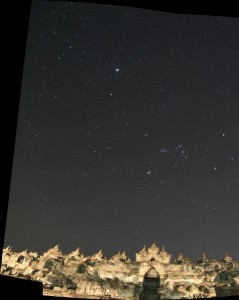
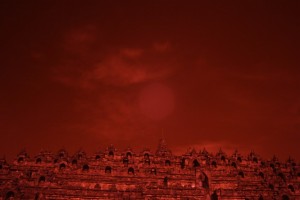
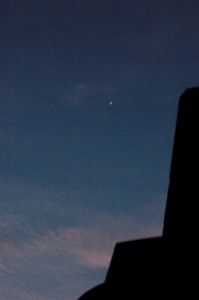
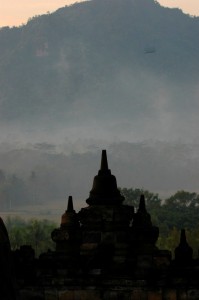
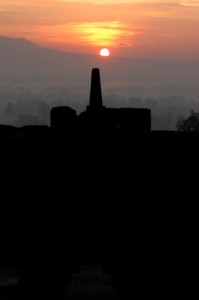

10 Comments
I do like your picture of Orion on its side. I live in England, and although I have been to many places including Siberia, north of the equator, it is only last year that I had the chance for a few days in Sydney and Wellington, so could see the Southern Cross from Sydney. And Leo upside down. So I have not had a chance to see Orion the other way up – or sideways. My special interest is in the early history of astronomy, so I am missing a very important part of the early history of astronomy.
Astronomy may have started in Indonesia, since people had to use boats to get to Australia from there, perhaps more than 70,000 years ago, and if they did not have good boats, and could not see where they were going, they would not have got far because of the dangerous seas and the crocodiles, sharks and jellyfish waiting for them to sink.
May I use part of your picture on my website or link to it. You may put a link to my website if you wish: cosmicelk.net.
[…] […]
@Heather: yes, please, feel free to use the pictures, and share with all the people. It seems that you have special interest in history of astronomy, so maybe someday we can exchange knowledge about the ancient history of astronomy? if you need a better picture of Orion, i can share with you some other pictures if you like & tx for your website 🙂
Dear Emanuel,
Great photo of Orion.
It is very likely that a monument like Borobudur would have some link to astronomy.
Such a great architectural feat could only have been done over long periods, and
would be a synthesis of the knowledge of the time, including in measuring time
and astronomy. As well for religious reasons, stars have been used as signs or symbols of divinity.
In the Tycho Brahe planetarium, in Copenhagen, Denmark, there was a few years
ago an introduction to astronomy starting very beatifully with an eclipse of the sun
over the temples of Borobudur. Very esthetic on a huge IMAX theater screen.
For sure indonesians must have been good astronomers in times past, they not only reached Australia, but as well Madagascar on the other side of the Indian Ocean.
This is quite a feat, comparable to the navigators of Hawaii who reached the South Pacific with lots of courage and intuition, but certainly a little bit of astronomy.
Thank you Jean-Pascal; yes, that is what are we looking for, there must be relation between the architectural and astronomy, surely many things we have to learn to have a good understanding about that, and if more archeo-astronomers have interest in this subject, it would be an exciting IYA in Indonesia!
what a beautiful pictures,
may a have those pictures for my collections Mr Mumpuni ???
sure do mr. Coe, you can have those, and also others from my collection in my facebook … 🙂
Hello,
We are Master students of National Taiwan University of Science and Technology.
We are doing a research about Heritage in Yogyakarta, center of Java. We choose Borobudur and Prambanan to survey how heritage impacted or merged in tourism sites in Indonesia.
And we really need your opinions about those two heritages so we could try our best to improve the tourism in heritage sites. Please help us fill the survey form.
Thank you for your help!! Thank you very much!!!
My e-mail: yaya24682006@yahoo.com.tw
The Survey Form address:
http://www.smart-survey.co.uk/v.asp?i=14289fwmcp
Best regards.
All of Students of Graduate Institute of Architecture and Historic Preservation.
waks ada videonya toh mas? kok gue gak tau … piye tohhhh
Helpful information about the monument. I am still researching about the early history of the area.
Regards
Barry Acott